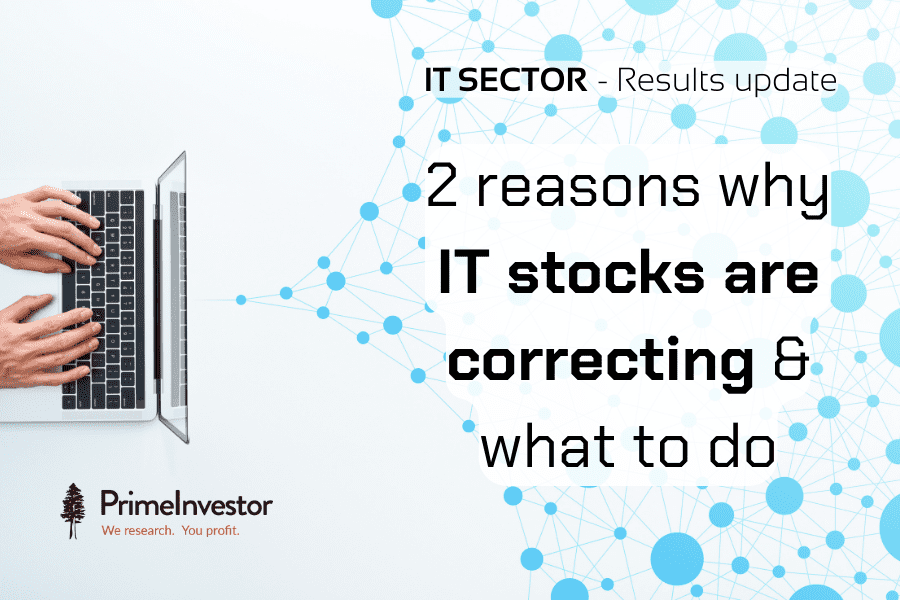A year ago, when we did the result review of the IT sector after the Q4FY21 earnings, the sector was moving to a new orbit on the back of robust growth prospects.
Read our earlier article here: Major IT stocks moving to a new orbit.
The Covid-19 pandemic increased the urgency of digital transformation for enterprises across the globe, and this paved the way for the IT sector to emerge as a strong growth story. Since we wrote about this last year, the sector has delivered stellar earnings performance during and post pandemic.
And earnings have continued to keep pace. Below is the earnings performance of the top large players and major mid-sized players for FY22 compared with the past 3 years. Mid-sized IT stocks emerged stronger than their larger peers and overall, FY22 turned out to be a big year for the sector. According to NASSCOM, FY22 has turned out to be one of the best growth years for the industry in the last 11 years with double digit growth.
Major players have guided double digit growth in FY23 as well, despite geo-political tensions. NASSCOM too, is ambitiously looking at a $350-billion industry by FY26 which calls for double digit growth rates of 11-12% CAGR. According to the industry body, the tailwinds of growth in the IT sector are very robust and the current digital drive will support growth for at least the next four to five years.
So far so good. But in the last two quarters, the stock prices of IT companies have been showing signs of a cool-off with concerns emerging on earnings growth momentum.
Post Q4 results, the correction has further accelerated. In this backdrop, let us look at what could have possibly caused the correction and what the sector holds for investors in future.

#1 Pressure on margins and earnings growth momentum
While Q4 is a seasonally weak quarter for IT stocks, it started off well with bellwether stock TCS delivering results in line with market expectations. There wasn’t any disappointment in deal wins or growth guidance, but there was margin pressure pulling down earnings growth. For TCS, EBIT margin at 25% for Q4 FY22 was below the company’s aspirational range of 26-28%.
The same is the case with Infosys where the growth guidance still remains strong, but the management has revised the lower end of margin guidance by 1% for FY23. Wipro, on the other hand, has seen its margins falling from 21% to 17% and sees the pressure continuing for two to three quarters while giving a tepid growth guidance for Q1 FY23. HCL tech was on track for growth while margins drifted to the lower end of guidance.
While TCS doesn’t give forward guidance, other majors have largely maintained double digit growth guidance for FY23 in the range of 12-15% with continuing margin pressures in the next two quarters. This has led the market to believe that earnings momentum is slowing down and a sharp correction followed.
When it comes to mid-sized players, there was a mixed trend. There are niche players in this segment focusing on specific areas such as engineering R&D, travel, retail, transportation, digital transformation, etc unlike top tier players where BFSI is a major vertical. But here again, the growth guidance (from two of the L&T group companies) in the range of 13-15% for FY23 has not gone well with the market, as their valuations were discounting higher growth.
While L&T Infotech focuses on BFSI, L&T Technology focuses on engineering R&D services.
Managements of Tata Elxsi, Persistent systems and Mphasis exhibited confidence on higher growth in FY23, though not providing any guidance. This prevented a steep fall in their prices despite super rich valuations.
The sector is also staring at a high base going into FY23. You can see how quarterly growth has panned out in FY22. Q1 and Q2 dominated the show on profitability while starting to moderate in Q3 and Q4. So, the market will be eagerly watching FY23 Q1 earnings and how companies can deliver growth on a high base, though expectations are low at this point of time.
#2 Headwinds on costs to stay
One of the key concerns from the Q4 earnings season for the sector was the headwinds on costs that may continue in the first half of FY23. The pressure on margins is coming from higher employee cost to prevent attrition, lower utilisation levels pursuant to more hiring and return of international travel. Overall, these factors combined together are expected to cause 1-3% impact on EBIT margins for companies in FY23.
Employee Attrition
This is one of the biggest challenges IT stocks have been facing in the last few quarters. Despite increasing wages to retain talent, companies had to boost hiring and provide training to new employees.
TCS, Infosys, Wipro and HCL Tech reported attrition of 17.4%, 27.7%, 23.8% and 21.9% respectively in Q4FY22, higher compared to 15.3%, 25.5%, 22.7% and 19.8% respectively in the preceding quarter. This compares with the attrition rates of 7% - 12% that existed for these players at the beginning of this financial year.
On the other hand, mid-sized players like Tata Elxsi and L&T Technology managed to control attrition at 20% while L&T Infotech, Mindtree and Persistent have seen higher attrition levels at 23.8%, 24% and 26% respectively.
Besides buoyancy in the job market for techies with specialised skills — such as cloud, cybersecurity, artificial intelligence, machine learning and others — a shift in employee perspective and work dynamics has been cited as factors for the rise in attrition by the companies. The management at Wipro believes that they will continue to face the high level of attrition at least in the next two-three quarters. This will likely continue to put pressure on costs and margins.
Utilisation levels
Utilization was down for the second quarter in a row, with both Infosys and Wipro reporting lower utilization (excluding trainees) at 87.0% and 85.2%, respectively from 88.5% and 85.8%, respectively.
For L&T Infotech, utilisation levels dropped to 81.5% from 82.2% while Mindtree managed to maintain it stable at 83%.
The rising share of freshers joining the workforce is cited as one of the possible reasons behind this fall as companies have to train them for a period before getting them into jobs. Top four IT service providers have added nearly 245,000 people (net recruits) in FY22. This is 50% more than what these companies added in the previous two fiscals cumulatively.
The companies are in a hiring spree in FY23 as well with TCS and Infosys guiding for 45,000 and 50,000 campus hires, respectively, while Wipro will hire 38,000 freshers. Mid-sized IT players are also not far behind, with robust hiring plans.
Other costs
Companies have been saving on travel and infrastructure costs during the pandemic that pushed the work from home culture and reduced international travel significantly. Now, with normalcy returning, companies will once again see a jack up in costs due to international travel and employees returning to offices.
Where valuations stand now?
As you can see from the table below, valuations in terms of PE ratio have significantly moderated for most of the large and mid-sized IT stocks post the recent correction. Most of the stocks have corrected between 15% and 45% from their 52-week highs Vs 14% correction for Nifty 50 and 25% for IT index from their 52-week highs. Below is where valuations stand now:
The severe correction in the mid-sized IT stocks has also to do with the steep rally they had in the past 1 year with their PE ratios rising to meteoric proportions.
So, has this sharp correction made valuations attractive?
Since IT services companies are known for high free cash generation, healthy RoE and balance sheets, we mainly need to look at growth and valuations. PE ratio still serves as a good guide on valuations for this sector.
For both large and mid-sized players, the period between FY17 to FY20 has been a low growth phase while they were growing at a decent pace until FY16. After the massive PE expansion that we saw in until mid FY22, the PE ratio has been contracting following the recent correction.
As far as the top tier IT stocks are concerned, the valuations are closer to their averages. Another 10% correction may take valuations to their historical averages witnessed during their growth phase prior to FY17, as can be seen from the chart below.
For the mid-sized IT stocks, the PE re-rating was sharper in FY 22 and some of them seem to be still holding up on their valuations despite recent corrections. So, their deviation from historical averages is still high. But then, these are also companies where growth tailwinds are strong.
What’s in store for investors?
The growth story that has panned out thus far appears to be healthy despite some margin concerns and near-term headwinds. If both current earnings growth and guidance are any indicators, the growth story remains healthy. Strong hiring trends also point to future growth momentum.
That means that the correction that has transpired (and may still) may be more driven by excessive valuations afforded for the robust growth witnessed, rather than due to any significant growth concerns.
The high valuation afforded is clearly tapering off. As valuations converge to their historical growth phase averages (pre FY17) investors might find opportunities to invest in. A further 10% correction in larger players can take the larger IT stocks to an attractive zone for investors.
On the other hand, there are few mid-sized IT stocks with clearer growth prospects trading at rich valuations. The valuation deviation for them still remains high compared to their historical averages. These are companies such as L&T Technology, Tata Elxsi and Persistent. In such cases, there is little room for error if there is any earnings dis-appointment in the coming quarters. So caution is warranted in such companies for fresh exposure. As explained in the beginning, some of the mid-sized players are operating in niche verticals and so a deeper dive into their prospects may help to spot out clear winners.
For both the larger players and mid-sized players with 15-25% earnings growth prospects, a PEG of 2X on a forward basis still looks fine for the sector considering the growth opportunity for the next few years.
Please check Prime Stocks for our recommendation in this space. All the data that we have used here are from Prime Stock Screener and you can also make use of it to run data, download it in excel, save in the stock screener itself and retrieve any time. The full suite of tools are available for Prime Growth subscribers.
Corporate actions that warrant caution
While the correction in the sector can make several IT stocks attractive, you need to be cautious of certain development underway in the industry. These developments can be in the nature of mergers, PE buyout and promoter stake decline. Here are some of them:
1. Mindtree L&T Infotech merger
A recent corporate announcement that happened on 6th May was the merger of Mindtree with L&T Infotech. Mindtree was acquired by L&T in 2019 from its promoters and scaled up the business since then. Due to low overlap between the businesses of L&T Infotech and Mindtree, the merger was awaited and finally announced by the management.
Shareholders of Mindtree will get 73 shares of L&T Infotech for every 100 shares they hold in Mindtree.
L&T will hold 68.73% of L&T Infotech after the merger, while currently L&T owns 61% of Mindtree and 74% of LTI. The combined entity will be led by Mindtree CEO Debashish Chatterjee, while L&T Infotech CEO and MD Sanjay Jalona has put in his papers.
L&T Technology services (LTTS), an engineering R&D company, will remain a separate company.
2. Promoter share reduction in Coforge
Coforge has been in news of late as its promoter, Barrings, has been cutting down its stake. Barrings has managed to sell 10% of its 50% stake in Coforge in March 2022. The stock has also corrected 34% from its peak.
As the promoter exits, investors may need to look at the long-term commitment of PE shareholders at this point of time before choosing to invest.
3. PE stake in Mphasis
Mphasis is another PE owned company where Blackstone acquired a 56% stake in 2021 from its another fund while it originally acquired Mphasis from HP in 2016. Being a PE player, one has to watch for its approach and plans for the company, although the company per se has been performing well.







6 thoughts on “Result update: 2 reasons why IT stocks are correcting and what to do”
Thank you for this review report.
In the Mid size category is it right to include Tata Elxsi for comparison? Are their products and services not different from rest of the companies compared?
Regards.
Welcome your query sir
In my understanding, Tata Elxsi is no different from others when we look at the Core Business Model
It is also a services Co where employee count drives growth majorly through outsourcing
Of course it caters to different segments lime Engineering R&D & Media unlike BFSI, which is the core segment for others
L&T Technology services also caters to similar areas plus Industry 4.0 (digital manufacturing) where Tata Elxsi is just foraying
You may treat it a bit different, or a niche or a better growth story in the way technology is gaining importance, but it is still a services model and an outsourcing story in my opinion
Just sharing my thought on it and welcome your comments or corrections
Thank you
Thankyou ,for your concise review of the sector. Would you also given US / Global recessions ahead, no one knows how long that would continue, IT infra spending by their clients is a risk ? And on top they have also added more human resources assuming current 15%+ growth also can add further risks in margins?
Thank you sir
The correction seems to be factoring the possibility of a recession. Otherwise, despite such a positive outlook from majority of the companies, the correction has been sharp.
It is a tricky situation as projects also saw postponement due to Covid while Ukraine crisis has also led to talent shortage. Indian companies were mentioning in the earnings call that had they hired more, they could have got more business as well
Q1 earnings season in July may give more clarity based on economic situation then after a couple of major rate hikes
How Honeywell Automation comes under earning compounder ? They 10 year CAGR growth remains under 8%.
5 out of the 10 years were capex downturn cycle. So past data may not really reflect. More importantly, Earnings compounders are steady growth plays not high growth plays. We have a separate category called high growth. thanks, Vidya
Comments are closed.